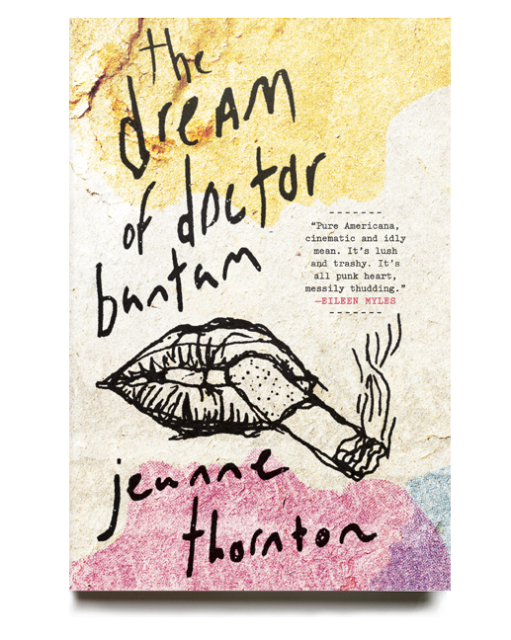I read The Dream of Doctor Bantam by Jeanne Thornton because Eileen Myles called the fantasy novel “pure Americana, cinematic and idly mean,” adding that “it’s all punk heart, messily thudding.” She said something about loss, and the description said something about lesbian romance.
When I received it in the mail, the only thing I thought was damn I love that cover.
The Dream of Doctor Bantam takes place in Austin, Texas, where it’s warm but sometimes super rainy and the book’s main character, Julie, spends a lot of time riding various bikes. One belongs to her dead sister Tabitha, who walks into a car headfirst trying to “out run time.” The other belongs to Ira, Tabitha’s ex and a thirty-something rabble-rouser who drinks Lone Star and publishes an activist paper, The Blue Collar Review, that nobody buys. His landlord, Patrice, is a “fascist beauty” with a weak heart but firm eyes and very nice legs. Julie falls for her, as any teenage lesbian would. She looks a little bit like Tabitha when she’s sad.
Patrice has issues.
Patrice belongs to The Institute of Temporal Illusions, a “religion” Thornton very accurately based off of Scientology in that it eats and spits out the people who go there. Patrice ascribes to it, studies it, works for it. Everyone in town calls it a cult, and Julie hates them, just like everyone else, but she finds it hard to hate Patrice. As she falls deep into an emotional struggle with herself to resolve her heart’s wringing for her deceased sister, her love for Patrice lands her smack-dab in the middle of the Institute’s clutches, pulling Patrice out with one hand and steadying herself with the other. Sometime along the way she comes to terms with her sexuality, falls in love with fucking a woman for the first time, and loses more than she could ever have imagined.
Julie is only 17.
What were you like in high school?
Patrice looked back down at her plate. Again, she thought about it before she answered.
I didn’t exist, she said finally, and she kept eating as Julie watched her.
What’s most striking about the book is the eerie world in which Julie lives that feels so much like home. How much we share her affinity for high school and her inability to let go, and how much of ourselves we hear in her heart beating while Patrice is asleep. How much we can identify with her deep desire to be loved without conditions and with ease, how much we wish for a less painful morning, how much we try and try to get the fuck out. And how we keep going when we can’t.
Thornton’s dialogue uses no quotation marks, and thus reads almost like a trail of thought. Almost like the space between thinking out loud and actually making a noise, where the book perches each character as well.
Her hair is wet and short and shining in yellow light. Her body is a hole around my hand. Her heart is a hole into which I’ve crawled. The pages turn back because time isn’t real. We are together because we need to be. We are together and we will survive.
When Julie and Patrice aren’t fighting about The Institute; when Patrice isn’t overworked and exhausted from staffing their front desk or participating in their manic rituals or teasing Julie for being ‘timebound,’ for refusing to believe that the crazy phenomena of escaping time that led her sister to suicide is not something she wants to keep in her heart, that’s when Patrice and Julie are simply in love. That tenderness of first love, of first girl-on-girl love, of finally knowing how you want to be forever and finding someone you can easily take with you.
The love story makes this a book for us. A book in our own strange, emotional, gravelly language. A precious sign of what goes on in our hearts and our heads and how it is to fall in love with someone unusual. Someone nobody would have picked for you. Someone you thought you’d never be able to pick.
Eileen Myles called it “messy.” I was ready for romance, for hot summer nights, for a heart beating merely to continue looking for truth. And if I haven’t given you enough reason to read it by now, just know it was all of that and more.


“In Julie Thatch you cannot help but see shades of Stieg Larsson’s Lisbeth Salander.”
I’m already reading two books (Thanks AS), but f*ck it, I’m on it!
This sounds fantastic! Thanks for sharing. (:
With a cover like that, I’d buy it right off the shelf. I’ve never really heard anyone describe a book as “messy”, but now that I have, it’s the perfect way to describe most of my favorite books. Messy. Eileen knows her shit. I love the writers at Autostraddle for always knowing what I should be reading.
Sold when you said it was set in Austin, increasingly sold as I read the rest of the article.
Thanks for the recommendations always!
创新建立广百社会责任模式,引领行业发展企业广受赞誉
Pingback: THE DREAM OF DOCTOR BANTAM is reviewed on Autostraddle - OR Books